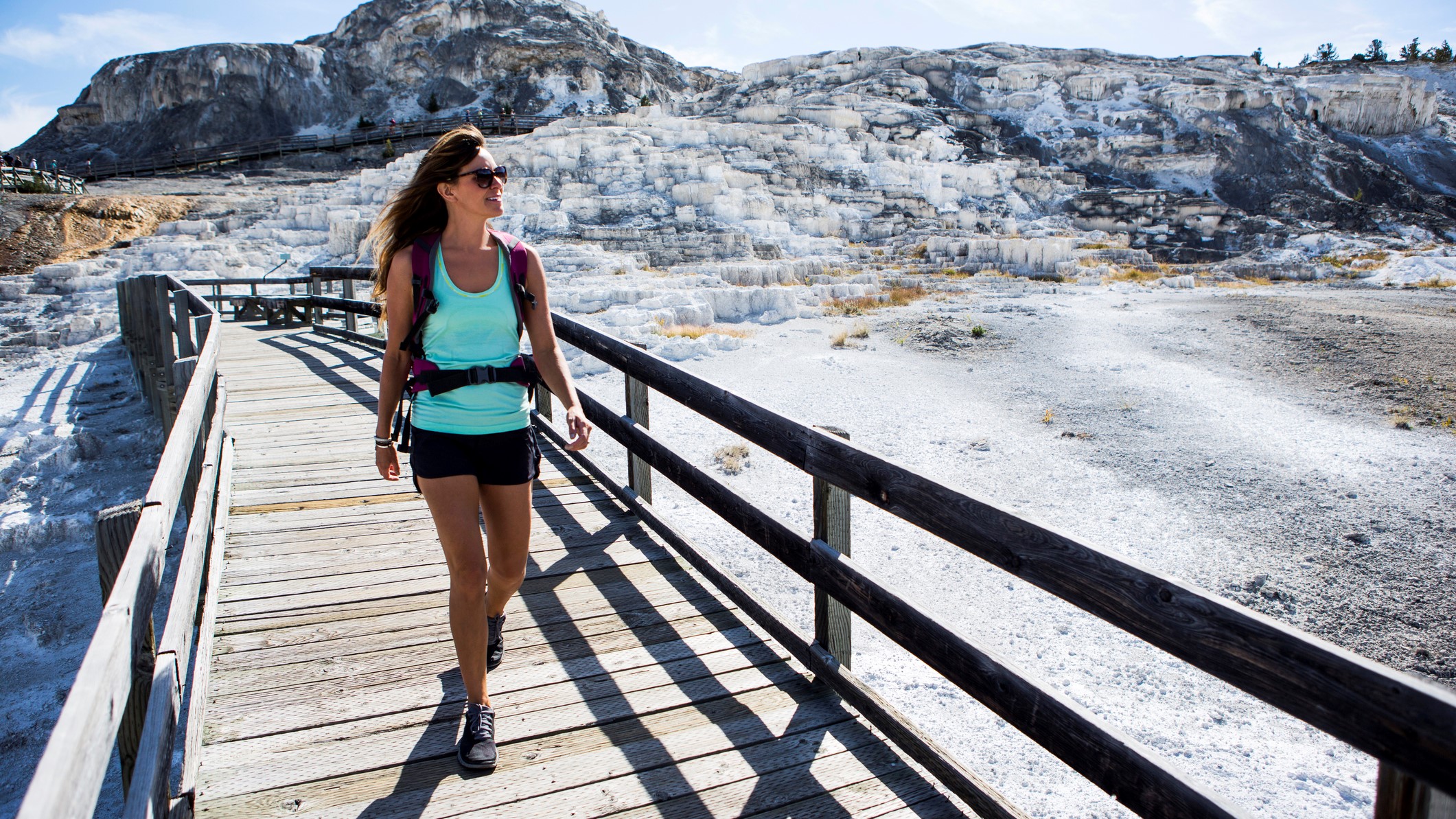
Have you heard of rucking? I highly recommend it.
Not long ago, I gave silent walking a try. It’s hardly revolutionary — you simply walk silently without your phone, music or podcasts — but I found it helpful for improving mental stamina. Rucking, on the other hand, is one for the physical stamina.
I started this challenge before picking up my first rescue dog this month. So, when my exercise routine reduced to very little during her first week of settling in, I decided to pick it back up in a bid to add intensity to my (once non-negotiable, now sporadic) walking routine.
If you’re still wondering what rucking means, it involves walking or hiking while wearing a weighted rucksack, backpack or similar. You can load up with whatever you like — water bottles, dumbbells, or the bricks from weighted vests, for example — as long as the load feels challenging.
Here’s what I learned from rucking — and why you may benefit from trying it.
What does rucking do to the body?
Depending on how you load your weight — I wore a rucksack on my back — rucking helps strengthen multiple muscle groups, including your core and back. The muscles surrounding your spine and the various core muscles all work together to support proper posture, so rucking regularly could help you stand a little taller and learn to engage your core properly while you move.
Other muscle groups at work include the upper trapezius muscles, upper and mid back and shoulders. If you suffer from a weak or tight upper back, rucking will soon tell you about it.
Get instant access to breaking news, the hottest reviews, great deals and helpful tips.
Think about that nagging shoulder ache you get after a long hike — that’s because your upper back muscles are working to support the load, but also because loading your back can cause some strain to these underused muscles.
If you try rucking yourself, it's important to stand tall and use your stomach to help drive your movement rather than hunching over and letting your shoulders do all the hard work.
Does rucking burn belly fat?
Rucking derives from military training, and remains a low-impact but effective way to build cardio, endurance and strength into one routine. I would guess in the military, the weights were much heavier and the distances much longer.
However, you’re not about to burn belly fat just from rucking. "Spot reduction" — being able to strip fat away from one part of your body through exercise alone — is a myth.
However, rucking contributes toward overall activity and helps burn energy. If you tip the scales in favor of burning more calories than you consume over time, you’re primed for losing fat in general, which can help you reduce belly fat naturally.
If you plan to try rucking yourself, start with a light weight and ensure you can walk properly with it. Over time, add weight and distance. I also recommend a comfortable backpack with thick straps and focus on standing tall without hunching.
Does rucking actually build muscle?
If my goal was to build muscle, I’d lift weights before I choose rucking. But technically, rucking does involve shifting heavy weight for sustained periods — just differently — which can help boost your metabolism, burn energy and build a stronger core.
Adding intensity to walks by hiking, power walking, or climbing hills will challenge your cardiovascular fitness and muscular strength more, but adding load really ramps up the resistance, helping to increase your output, burn calories and build strength. After all, your muscles must work harder to shift the weight.
But it's not always clear whether you should use hypertrophy or strength training to build muscle, which is why, often, it comes down to your goals and personal preference.
So, to find out more, I gave rucking a try and here's what I learned.
It was hard work
I have very short legs, so even the slightest incline feels a whole lot steeper than I’d like; add a backpack loaded with bricks from my weighted vest (I’ve walked with a weighted vest before, it’s not easy!), and you’ve ramped up my rate of perceived exertion (RPE) tenfold.
My timing for this challenge could have been better. The U.K. has seen the hottest spring possibly on record, and I live in a hilly part of London. So, as I headed out walking wearing my heavy backpack in pretty sweaty temperatures (okay, 23 degrees Celsius/ 75 Fahrenheit isn’t groundbreaking, but it still amped up the intensity), I was puffing and panting pretty quickly.
This bag made it into our line-up for the best gym bags, and it's the exact one I used to go rucking with. It is huge, which means you can pack plenty into it. The straps are also thick and plush, so long distances feel a lot kinder to the shoulders.
It was a full-body workout
I genuinely went into this challenge thinking a little weight wouldn’t do much. I consider myself pretty fit and healthy — I’m also a personal trainer by trade, so I love fitness and enjoy the odd 5K run alongside my CrossFit and yoga routine.
Boy, was I mistaken.
I did a quick dig before rucking for the first time, and found the general consensus was to add weight at around ⅓ or less of your bodyweight. As a 126 lb female, that’s roughly 42 lbs of weight (or three stone for the U.K. Tom’s Guide contingent).
Even a 30-minute walk had me blowing on the hills, and I could feel my back and core muscles working hard to keep me upright when all I wanted to do was lean forward into the incline, which would have strained my lower back over time.
Then, there’s the leg workout. I could feel my hamstrings, quads and glutes working to power me up and down; even short distances created intensity I didn’t expect.
Full-body workout? Tick.
My back hurt, but it was my own fault
Firstly, advice differs here, but I wouldn’t recommend rucking every day for the rest of your life, especially if you want to ruck heavy. And I definitely wouldn’t run while carrying weight like this. Over time, it can increase the likelihood of joint pain, postural issues and muscular strain or overuse.
Despite my best efforts, I found myself hunching my shoulders and leaning forward; a slight lean can help engage your glutes, but my lean was the type you do when your muscles feel fatigued. Note to self: form first.
My verdict

Rucking upped my cardiovascular effort and worked muscles across my entire body. And while I’d like to keep some future dog walks ruck-free, it’s still a game changer, providing me a full-body workout (cardio and strength) on days when I can’t make the gym.
Sure, I’ve hiked with a backpack many times before, but a ruck along the streets of London or in my local park just added a little bit of magic to my daily routine. And it also felt like the most effortless way to add more effort to walks when I didn’t have time for, say, a CrossFit class.
And the best part of all: rucking gets you out in nature, stimulating your mind and boosting emotional wellbeing.
More from Tom's Guide
- How to lose weight and get in shape by walking
- I tried the ‘Japanese walking’ method for a week — and I’m hooked
- This one simple exercise reduces stiffness in your hips and boosts mobility — according to a personal trainer

Sam Hopes is a level 3 qualified trainer, a level 2 Reiki practitioner and fitness editor at Tom's Guide. She is also currently undertaking her Yoga For Athletes training course.
Sam has written for various fitness brands and websites over the years and has experience across brands at Future, such as Live Science, Fit&Well, Coach, and T3.
Having coached at fitness studios like F45 and Virgin Active and personal trained, Sam now primarily teaches outdoor bootcamps, bodyweight, calisthenics and kettlebells.
She also coaches mobility and flexibility classes several times a week and believes that true strength comes from a holistic approach to training your body.
Sam has completed two mixed doubles Hyrox competitions in London and the Netherlands and finished her first doubles attempt in 1:11.
You must confirm your public display name before commenting
Please logout and then login again, you will then be prompted to enter your display name.

